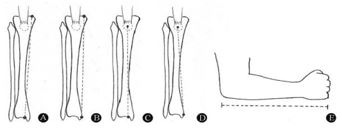The Correlation Of Various Anthropometric Measurements With Tibia Interlocking Nail Length Measured Intra-Operatively
Abstract
Background: A proper and accurate size of tibial nail insertion is necessary for better functional outcome and to prevent complications related to improper nail length. Various preoperative and intraoperative measures are used, with varied accuracy for nail size estimation. With aim to find out the best anthropometric measure correlating with the tibial nail length, we correlated various anthropometric measurements to actual size of tibial interlock nail used in 100 cases of tibial shaft fracture.
Material & Methods: 5 anthropometric parameters were measured i.e. (1) distance from medial knee joint line to ankle joint line (K-A) (2) distance from medial knee joint line to medial malleolus (K-MM) (3) distance from tibial tuberosity to ankle joint (TT-A) (4) distance from tibial tuberosity to medial malleolus (TT-MM) (5) distance from tip of olecranon to 5th metacarpal head (O-MH) in 100 cases of tibial shaft fractures treated with interlocking nail and were correlated with the tibial nail size used.
Results: Mean size of nail used was 33.61±1.69 mm (range 28 to 36 mm). Mean of five anthropometric parameters for K-A, K-MM, TT-A, TT-MM and O-MH, were 35.61±1.59 (range 30 to 39 mm), 37.16 +1.36 (range 32 to 41.5 mm), 33.58 ± 1.79 (range 28 to 37 mm), 34.40 ± 1.21 (range 30 to 39 mm), and 33.10 ± 1.61 (range 28 to 36 mm) respectively.
Conclusion: All anthropometric parameters i.e. TT-A, TT-MM, K-A, K-MM and O-MH can be used for nail size prediction. O-MH was nearly accurate to the nail size as compared to other methods because of interpersonal variation in palpation of tibial tuberosity.
Downloads
References
Duan X, Al-Qwbani M, Zeng Y, Zhang W, Xiang Z. Intramedullary nailing for tibial shaft fractures in adults. Cochrane Database Syst Rev 2012:CD008241.
McGrath L, Royston S. Fractures of the tibial shaft (including acute compartment syndrome). Surg. 2007;25:439-44.
Court-Brown CM, Caesar B. Epidemiology of adult fractures: a review. Injury. 2006;37:691–7.
Hernández-Vaquero D, Suárez-Vázquez A, Iglesias-Fernández S. Dynamisation and early weight- bearing in tibial reamed intramedullary nailing: its safety and effect on fracture union. Injury. 2012;43:S63–7.
Krettek C, Schandelmaier P, Rudolf J. Current status of surgical technique for unreamed nailing of tibial shaft fractures with the UTN (unreamed tibia nail). Unfallchirurg. 1994;97:575–99.
Galbraith JG, O'Leary DP, Dailey HL. Preoperative estimation of tibial nail length because size does matter. Injury. 2012;43:1962–8.
Waldron VD. Predicting intramedullary nail length. Am J Orthop. 1998;27:383-6.
Mosheiff R, Peyser A, Friedman A. “Krammer splint technique’’ for immediate measuring of intramedullary nails. Am J Orthop (Belle Mead NJ) 1997;26:375-9.
Blair S. Estimating tibial nail length using forearm referencing. Injury. 2005;36:160–2.
Colen RP, Prieskorn DW. Tibial tubercle-medial malleolar distance in determining tibial nail length. J Orthop Trauma. 2000;14:345–8.
Venkateswaran B, Warner RM, Hunt N. An easy and accurate preoperative method for determining tibial nail lengths. Injury. 2003;34:752–5.
Issac RT, Gopalan H, Abraham M, John C, Issac SM, Jacob D. Preoperative determination of tibial nail length: An antropoemetric study. Chin J Traumatol. 2016;19(3):151–5.

The entire contents of the Orthopaedic Journal of Madhya Pradesh Chapter are protected under Indian and International copyrights. Orthopaedic Journal of Madhya Pradesh Chapter allow authors to retain the copyrights of their papers without restrictions, Authors grant the publisher the right of exclusive publication. The Journal then grants to all users a free, irrevocable, worldwide, perpetual right of access to, and a license to copy, use, distribute, perform and display the work publicly and to make and distribute derivative works in any digital medium for any reasonable non-commercial purpose, subject to proper attribution of authorship. The journal also grants the right to make numbers of printed copies for their personal non-commercial use under Creative Commons Attribution-Non-commercial share alike 4.0 International Public License.

 OAI - Open Archives Initiative
OAI - Open Archives Initiative












